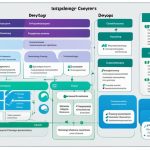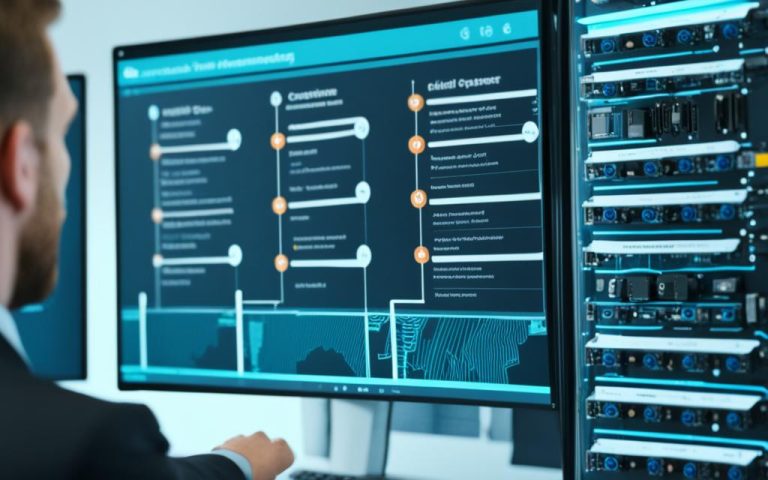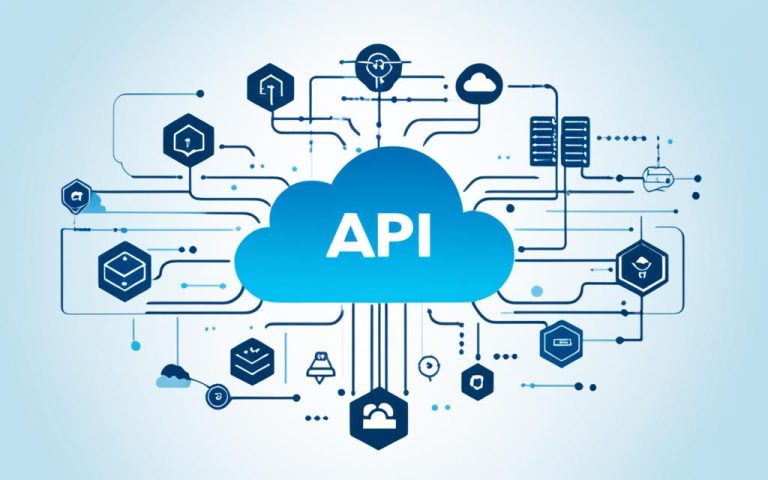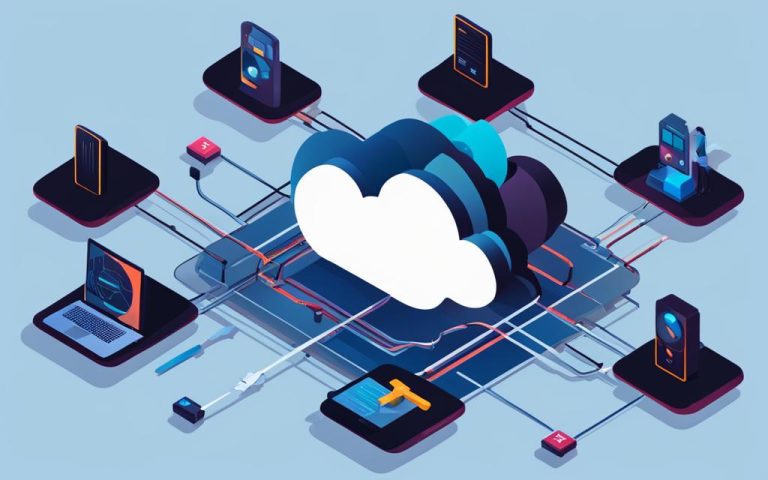Compliance monitoring is a critical aspect for businesses operating in the cloud. It involves implementing cloud compliance tools to manage network operations and ensure adherence to regulations in the cloud environment.
Failure to meet compliance requirements can result in severe consequences, including expulsion from industry groups, hefty fines, and even legal prosecution. To avoid these risks, organizations must have a robust compliance monitoring strategy that covers various areas such as application design, development, and ongoing operations.
Understanding the specific regulations and standards that apply to the industry is crucial. Common compliance standards include GDPR, the Sarbanes-Oxley Act, HIPAA, and PCI DSS. By implementing monitoring practices and tools based on the compliance requirements and the cloud platforms they use, organizations can ensure the security of their network and meet compliance standards.
Understanding Compliance Requirements and Key Monitoring Tasks
In order to ensure compliance, companies must track and adhere to the regulations and standards specific to their industry. Compliance monitoring in the cloud involves various tasks that cover different areas of operation. These tasks include:
- Application-access monitoring
- Database protection
- Application change management
- Incident management
- Network monitoring
- Log monitoring
A centralized view of compliance status across all these domains can be created using data collected by cloud and network monitoring tools. It is essential for organizations to divide these tasks into two categories: design-time and run-time considerations.
Design-time considerations ensure that compliance standards are met during the development phase of cloud applications. This involves implementing controls and practices that align with the required compliance requirements. On the other hand, run-time considerations involve continuous surveillance to validate compliance during cloud operations.
Specific tools and procedures depend on how compliance requirements align with these categories.
| Compliance Task | Description |
|---|---|
| Application-Access Monitoring | Tracking and analyzing user access to cloud applications to ensure compliance with security and privacy policies. |
| Database Protection | Implementing measures to secure databases and protect sensitive information from unauthorized access or breaches. |
| Application Change Management | Controlling and documenting changes made to cloud applications to maintain compliance and minimize risks. |
| Incident Management | Establishing processes to detect, respond to, and resolve security incidents or compliance violations. |
| Network Monitoring | Monitoring network infrastructure and traffic to identify and address anomalies or security risks. |
| Log Monitoring | Collecting and analyzing logs of system activities to identify any deviations from compliance requirements. |
Tools for Cloud Compliance Monitoring
Organizations can leverage a range of tools to ensure effective cloud compliance monitoring. These tools play a vital role in addressing software security, enabling audit capabilities, and facilitating compliance management. By utilizing appropriate cloud compliance monitoring tools, organizations can validate compliance, detect violations, and maintain a strong security posture.
Design-Time Compliance Tools
During the development pipeline, design-time compliance tools enforce adherence to compliance requirements, ensuring that software is built in accordance with applicable standards. Two prominent tools in this category are:
- Veracode: Veracode provides application security solutions that incorporate automated security testing, static analysis, and secure coding practices to identify and remediate vulnerabilities.
- Checkmarx: Checkmarx is an industry-leading static code analysis tool that helps developers identify and resolve security vulnerabilities in their code, reducing the risk of non-compliance.
Audit Software and Data Practices Tools
To ensure compliance with regulations, it is essential to have robust audit capabilities and well-defined data practices. The following tools assist in validating compliance and maintaining a secure environment:
- Momentum QMS: Momentum QMS is audit software that enables organizations to establish, track, and manage compliance processes, ensuring adherence to regulatory requirements.
- Black Duck from Synopsys: Black Duck is a leading open source management platform that assists in identifying and mitigating risks associated with using open source components and libraries.
- Gensuite: Gensuite offers a comprehensive suite of compliance management tools designed to streamline processes, enhance data accuracy, and ensure compliance with industry regulations.
Compliance Management and Validation Tools
To maintain compliance, organizations need to control user access, manage logs and events, and validate design-time compliance. The following tools enable comprehensive compliance management and validation:
Active Directory and LDAP: Active Directory and LDAP are widely used directory services that provide centralized control over user access management, ensuring compliance with access control policies.
Dynatrace, Sumo Logic, and SolarWinds: These log and event management tools offer real-time monitoring and analysis of logs and events, helping organizations validate design-time compliance and detect potential compliance violations.
By leveraging these cloud compliance monitoring tools, organizations can strengthen their compliance management practices, safeguard software security, and ensure adherence to regulatory requirements.
Key Compliance Standards and Regulations
In order to ensure compliance in the cloud, businesses need to adhere to various standards and regulations. These compliance requirements aim to protect data and ensure the security of sensitive information. The following are some key compliance standards and regulations that apply to businesses operating in the cloud:
1. Payment Card Industry Data Security Standard (PCI-DSS)
PCI-DSS is a set of security standards designed to ensure the secure processing of credit card information. It provides guidelines for organizations handling credit card data to prevent data breaches, fraud, and unauthorized access.
2. ISO 27001
ISO 27001 is an international standard that outlines the requirements for an information security management system (ISMS). It provides organizations with a framework to manage the security of their assets, including data and information systems.
3. Sarbanes-Oxley Act (SOX)
The Sarbanes-Oxley Act sets requirements for financial reporting and disclosure. It aims to prevent corporate fraud and ensure the accuracy and transparency of financial data. Compliance with SOX is necessary for organizations operating in the cloud that deal with financial information.
4. General Data Protection Regulation (GDPR)
GDPR is a regulation that focuses on data protection and privacy for individuals within the European Union (EU) and the European Economic Area (EEA). It sets guidelines for the collection, use, and processing of personal data, and imposes strict penalties for non-compliance.
5. California Consumer Privacy Act (CCPA)
CCPA is a state-level privacy law in California that provides California residents with enhanced privacy rights. It requires businesses to disclose how they collect, use, and share personal information and gives consumers the right to opt out of the sale of their personal data.
6. Health Insurance Portability and Accountability Act (HIPAA)
HIPAA is a U.S. federal law that sets standards for the protection of sensitive patient data, known as protected health information (PHI). HIPAA applies to healthcare providers, health plans, and other entities that handle PHI.
7. Federal Risk and Authorization Management Program (FedRAMP)
FedRAMP is a government program that provides a standardized approach to security assessment, authorization, and continuous monitoring for cloud services used by federal agencies. It ensures that cloud services meet rigorous security and compliance standards.
| Compliance Standard | Description |
|---|---|
| PCI-DSS | Secure credit card information processing |
| ISO 27001 | Framework for information security management |
| SOX | Requirements for financial data accuracy |
| GDPR | Focus on data protection and privacy |
| CCPA | State-level privacy law in California |
| HIPAA | Standards for sensitive patient data protection |
| FedRAMP | Standardized approach to cloud security for federal agencies |
Compliance with these standards and regulations is essential to protect data, ensure data privacy, and maintain the trust of customers. By understanding and adhering to these compliance requirements, businesses can mitigate risks and operate securely in the cloud environment.
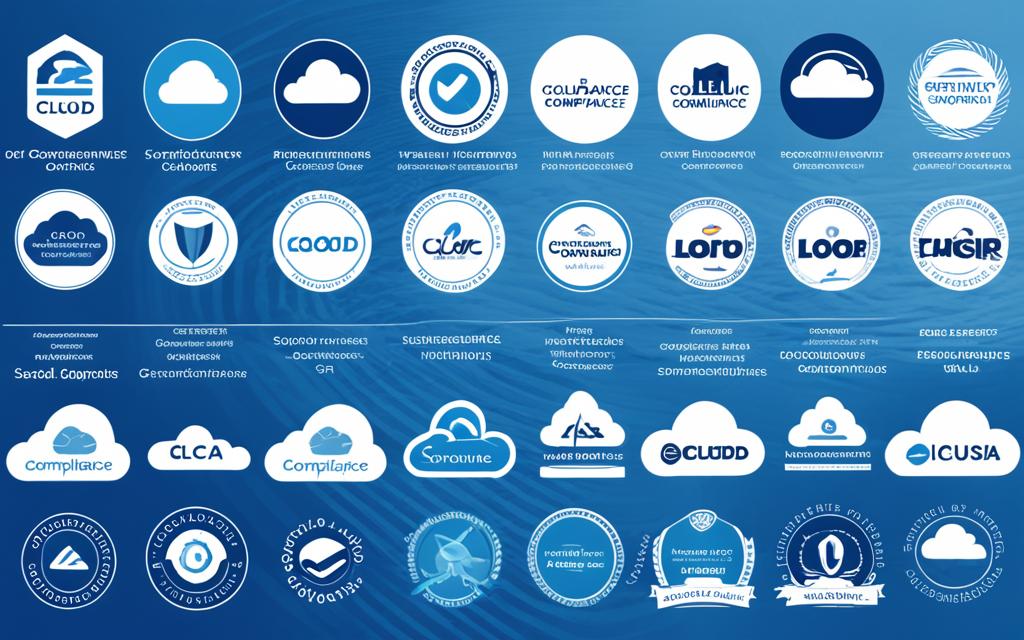
Importance of Cloud Security Compliance and Shared Responsibility
Ensuring cloud security compliance is of utmost importance in today’s digital landscape. With the increasing reliance on cloud computing, organizations must prioritize the protection of sensitive data and adhere to industry regulations. Cloud security compliance not only helps mitigate the risk of data breaches and cyber threats but also enables organizations to avoid costly fines, build trust with customers, and protect their brand reputation.
Data protection is a central aspect of cloud security compliance. Organizations must implement robust measures to safeguard their data from unauthorized access, theft, or loss. This includes encryption, access controls, and secure storage practices. By adhering to compliance requirements, organizations demonstrate their commitment to protecting the confidentiality, integrity, and availability of their data.
However, ensuring cloud security compliance is a shared responsibility between organizations and cloud providers. While organizations are responsible for securing their data and applications in the cloud, cloud providers play a crucial role in securing the underlying cloud infrastructure. This shared responsibility model requires clear communication, understanding, and collaboration to establish and maintain a robust security framework.
Organizations should carefully assess cloud providers’ compliance capabilities to ensure they meet the necessary standards and regulations. Cloud providers should offer transparent information about their compliance certifications, audit reports, and security measures. This enables organizations to make informed decisions when selecting a cloud provider and ensures that the chosen provider aligns with their compliance obligations.
By working together, organizations and cloud providers can achieve and maintain cloud security compliance effectively. This collaborative effort not only strengthens data protection but also fosters a culture of trust, accountability, and continuous improvement in cloud security practices.
Benefits of Cloud Security Compliance
Compliance with cloud security standards and regulations offers several key benefits:
- Protecting sensitive data: Cloud security compliance measures safeguard confidential and sensitive information from unauthorized access, reducing the risk of data breaches.
- Avoiding fines and penalties: Compliance violations can result in substantial financial penalties. By adhering to cloud security compliance requirements, organizations can mitigate the risk of regulatory fines and costly legal consequences.
- Building customer trust: Compliance demonstrates a commitment to data protection, enhancing customer trust and loyalty. Customers are more likely to engage with organizations that prioritize data security and comply with industry regulations.
- Protecting brand reputation: Data breaches and non-compliance can have severe negative impacts on a company’s reputation. Maintaining cloud security compliance helps protect the brand image and reputation.
- Achieving business continuity: Robust cloud security compliance measures ensure the availability and reliability of critical systems, minimizing downtime and enabling smooth business operations.
Implementing and maintaining cloud security compliance is an ongoing journey that requires continuous monitoring, regular assessments, and proactive risk management. By prioritizing data protection and actively embracing shared responsibility, organizations can effectively navigate the evolving landscape of cloud security compliance.
Cloud Security Compliance: A Shared Responsibility
| Responsibilities | Organizations | Cloud Providers |
|---|---|---|
| Securing data and applications | Organizations must implement robust security measures to protect their data and applications in the cloud. | Cloud providers are responsible for securing the underlying cloud infrastructure and ensuring its integrity and availability. |
| Compliance awareness and understanding | Organizations must have a clear understanding of compliance requirements and obligations in their industry. | Cloud providers should offer transparent information regarding their compliance certifications and security measures. |
| Regular monitoring and risk assessment | Organizations should continuously monitor their cloud environment for security vulnerabilities and conduct regular risk assessments. | Cloud providers should implement robust security measures, conduct regular audits, and provide customers with relevant security reports. |
| Incident response and breach management | Organizations must have incident response plans in place to swiftly address security incidents and data breaches. | Cloud providers should have procedures in place to promptly respond to incidents and communicate with affected customers. |
| Continuous improvement and compliance updates | Organizations should stay updated on evolving compliance requirements and adapt their security practices accordingly. | Cloud providers should regularly update their security measures and compliance capabilities to address emerging threats and new regulations. |
Conclusion
Ensuring compliance with regulations and standards is of utmost importance for organizations operating in the cloud. Compliance monitoring should encompass all aspects, including application design, development, and ongoing operations. A key factor in validating compliance and detecting violations is the use of cloud compliance monitoring tools.
Compliance standards and regulations, such as PCI-DSS, ISO 27001, SOX, GDPR, CCPA, HIPAA, and FedRAMP, play a critical role in maintaining data protection and regulatory compliance. Cloud security compliance is vital as it safeguards sensitive data, instills trust in customers, and contributes to the long-term success of businesses.
Achieving cloud security compliance requires a shared responsibility model between organizations and cloud providers. While organizations must secure their data and applications in the cloud, cloud providers are responsible for the security of the cloud infrastructure. By adhering to best practices and guidelines, organizations can establish and maintain a robust security framework in today’s digital age.
FAQ
What is cloud compliance monitoring?
Cloud compliance monitoring is the process of ensuring that businesses operating in the cloud adhere to specific regulations and standards. It involves monitoring various aspects such as application design, development, ongoing operations, and network management to ensure compliance.
Why is compliance monitoring important in the cloud?
Compliance monitoring is crucial for businesses in the cloud as failure to meet compliance requirements can lead to severe consequences such as expulsion from industry groups, hefty fines, and legal prosecution. It helps organizations avoid these consequences by ensuring adherence to industry regulations and standards.
What are some common compliance standards in the cloud?
Common compliance standards in the cloud include GDPR (General Data Protection Regulation), the Sarbanes-Oxley Act (SOX), HIPAA (Health Insurance Portability and Accountability Act), and PCI DSS (Payment Card Industry Data Security Standard).
What tasks are involved in cloud compliance monitoring?
Cloud compliance monitoring involves tasks such as application-access monitoring, database protection, application change management, incident management, network monitoring, and log monitoring. These tasks help validate compliance and detect any violations within the cloud environment.
What tools can organizations use for cloud compliance monitoring?
Organizations can utilize various tools for cloud compliance monitoring. Some tools for design-time compliance standards include Veracode and Checkmarx for enforcing compliance during the development pipeline. Audit software and data practices tools like Momentum QMS, Black Duck from Synopsys, and Gensuite can also be helpful. Compliance management tools such as Active Directory and LDAP, as well as log and event management tools from Dynatrace, Sumo Logic, and SolarWinds, play a crucial role in validating compliance and detecting violations.
What are some key cloud compliance standards and regulations?
Key cloud compliance standards and regulations include PCI-DSS (Payment Card Industry Data Security Standard), ISO 27001 (International Organization for Standardization), SOX (Sarbanes-Oxley Act), GDPR (General Data Protection Regulation), CCPA (California Consumer Privacy Act), HIPAA (Health Insurance Portability and Accountability Act), and FedRAMP (Federal Risk and Authorization Management Program).
Why is cloud security compliance important?
Cloud security compliance is important for protecting sensitive data in the cloud, adhering to industry regulations, avoiding fines, building trust with customers, and safeguarding the long-term success of businesses.
What is the shared responsibility model in cloud security compliance?
The shared responsibility model in cloud security compliance entails a collaborative effort between organizations and cloud providers. While organizations are responsible for securing their data and applications in the cloud, cloud providers are responsible for the security of the cloud infrastructure. A clear understanding and communication of compliance obligations are crucial in maintaining a robust security framework.




